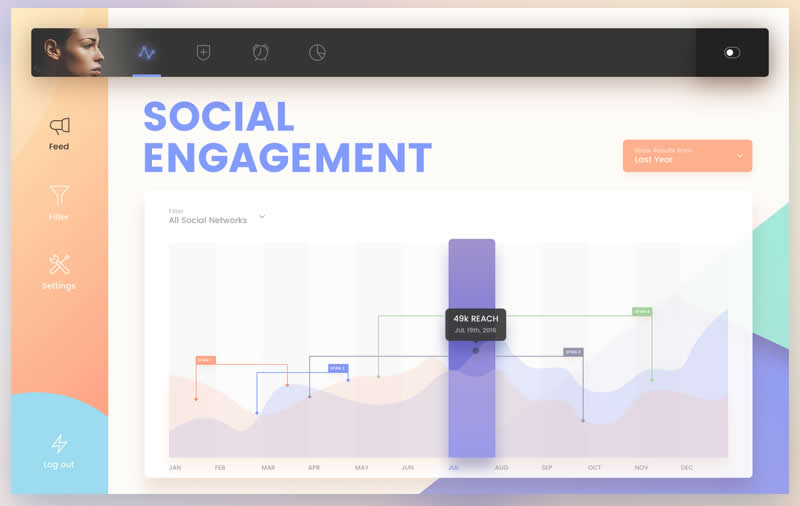Although your job is to create high-quality designs for the web, your contribution is incredibly important to the marketing process. By taking time to brush up on common marketing terms, you’ll gain a better understanding of your work within the larger context of marketing.
As a bonus, you may also learn a few terms that you can use in your discussions with employers and clients, impressing them with your marketing lexicon and know-how.
Here are the marketing terms you need to start with:
1. A/B Testing
A/B testing is a marketer’s version of the scientific method. Rather than resort to doing a complete overhaul of a site’s design, content, typography, or colors when it’s clear that something isn’t right, marketers use an A/B testing tool to try out an alternate version of the website (usually only changing one element).
2. Analytics
Analytics are, simply put, data points. Email open rates, blog visitors, paid search clicks, video views, etc. These are all different types of data that can be gleaned from marketing analytics.

3. B2B
B2B stands for “business-to-business” and refers to the two parties involved in marketing engagements. In other words, B2B is when a business’s target audience is another business.
4. B2C
B2C stands for “business-to-consumer.” This is the case when a business’s target audience is a consumer (i.e. a non-business entity).
5. Bounce Rate
This term refers to the percentage of visitors who abandon a site from a single page. This statistic is usually tracked to determine the most common part of a website where visitors lose interest. Here’s a quick guide to help you improve your site’s bounce rate.
6. Brand Identity
A business’s identity encapsulates any and everything that people may use in association with a brand. This may include the company name, logo, tagline, brand colors, typography, photography, content voice, and so on.

Marmal Brand Identity by Monika Kusheva.
7. Buyer Persona
This is the identity that businesses create for their target consumers, enabling them to shape their content and marketing efforts in a way that appeals to the generalized depiction of the persona. This persona can be built using demographics, geographic information, behavior history, and more.
8. Call-to-Action
Every piece of marketing collateral and every page of a website should have a clear goal for a business’s audience. A call-to-action is the message that directs visitors on how to take the next step to complete that goal.
9. Content
Content is everything that fills in the body of a website – text, images, videos, calls-to-action, sidebar widgets, animations, icons, etc.
10. Conversion
A conversion is the end goal of marketing, but it’s not always the same for every website. For membership websites, a conversion would be a visitor purchasing a membership. For e-commerce stores, a conversion would be the sale of a product. For bloggers, it would be a new subscriber to their RSS feed.
11. Engagement
Engagement refers to any interaction between a business and the end user. Marketers most commonly use this term when talking about social media interactions (e.g. likes, shares, comments).

Dashboard Experiment by Paul Flavius Nechita
12. Evergreen Content
Content that is “evergreen” means that it’s not time-specific. In other words, it will remain valuable and relevant regardless of when someone views it.
13. Friction
Friction in marketing is when there’s a disruption to the user experience as they attempt to complete an action.
14. Inbound Marketing
Inbound marketing requires tactics that are subtle, often focused on demonstrating expertise and knowledge instead of trying to sell.
15. Jacking
Jacking (as in hijacking) is when a trending idea is taken from somewhere else and spun for a business’s own purposes. Examples of this are newsjacking, trendjacking, and memejacking.
16. Key Performance Indicator
A key performance indicator (or KPI) is a measure of success against a goal.

17. Keyword
Keywords are the focus terms marketers use to build each piece of written content around. They are one of the ways content can be optimized for search engines.
18. Landing Page
Every page of a website is a landing page. In marketing speak, however, landing pages are usually ones built with a specific sales goal in mind.
19. Lead
A lead is the marketing term for a potential customer.
20. Marketing Automation
Marketing automation is the process by which a repeatable task or process is systematized by software.
21. Mobile Optimization
Mobile optimization is the generic term for designing a website with the mobile user in mind. Responsive design and page speed assessments are examples of mobile optimization.

22. On-page Optimization
On-page optimization refers to any sort of search-related optimization applied to a web page. This includes things like responsive layouts and text optimization through the use of metadata.
23. Off-page Optimization
Off-page optimization refers to any sort of search-related optimization task done outside of a website. Social media and linking opportunities are two examples of this.
24. Outbound Marketing
Outbound marketing tactics are ones that are explicit in their sales intent.
25. Pain Point
Every solution, service, or product should aim to solve a customer pain point. These are usually defined when creating buyer personas.
26. Repurposing
Repurposing is the process by which a piece of content is revamped as something else. For instance, marketers may take a well-received blog post and discuss that same topic during a live video session.
27. Search Engine Optimization
Search engine optimization (SEO) is any marketing tactic or process that aids in improving a website’s rank in search. On-site and off-site optimization are types of SEO.

28. Social Proof
Social proof refers to a consumer’s reliance on the testimony of other users to determine how they feel about a brand. Testimonials, product reviews, ratings, and photos of a company’s products from customers are examples of social proof.
29. Thought Leader
A thought leader is a person who’s seen as an influencer or expert on a certain matter. Marketers often refer to inbound marketing content as thought leadership content.
30. User Experience
In marketing, user experience (UX) is most commonly associated with a consumer’s experience using something. There is an approach in web design called UX design that wholly focuses on creating every inch of a website based on what is known about the audience’s preferences, behaviors, and goals.
This post may contain affiliate links. See our disclosure about affiliate links here.